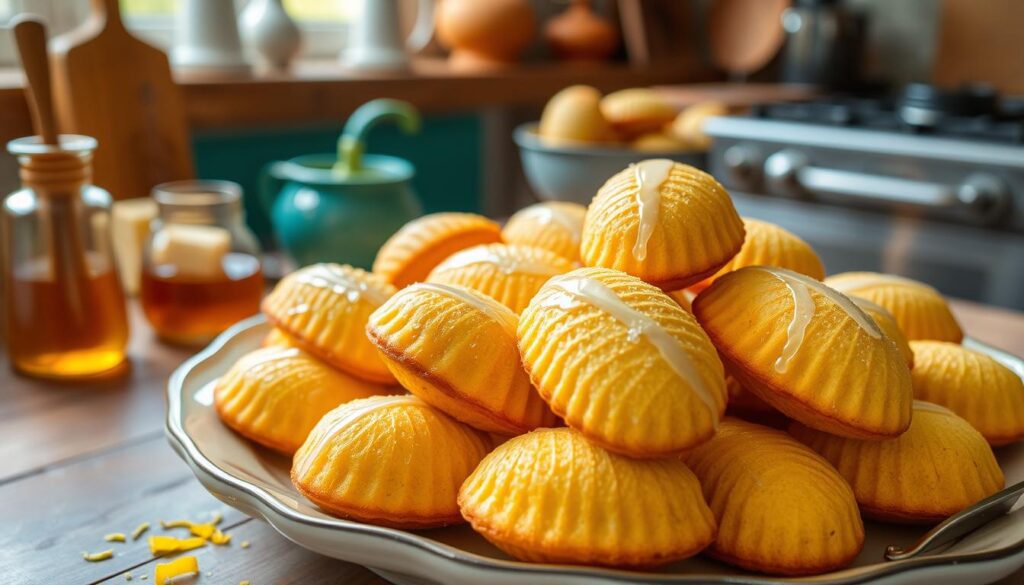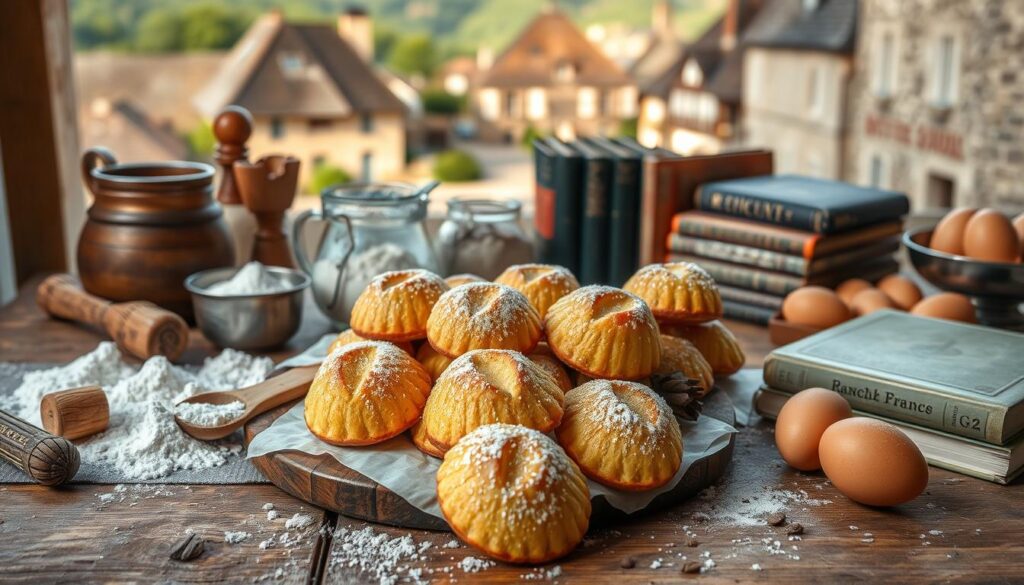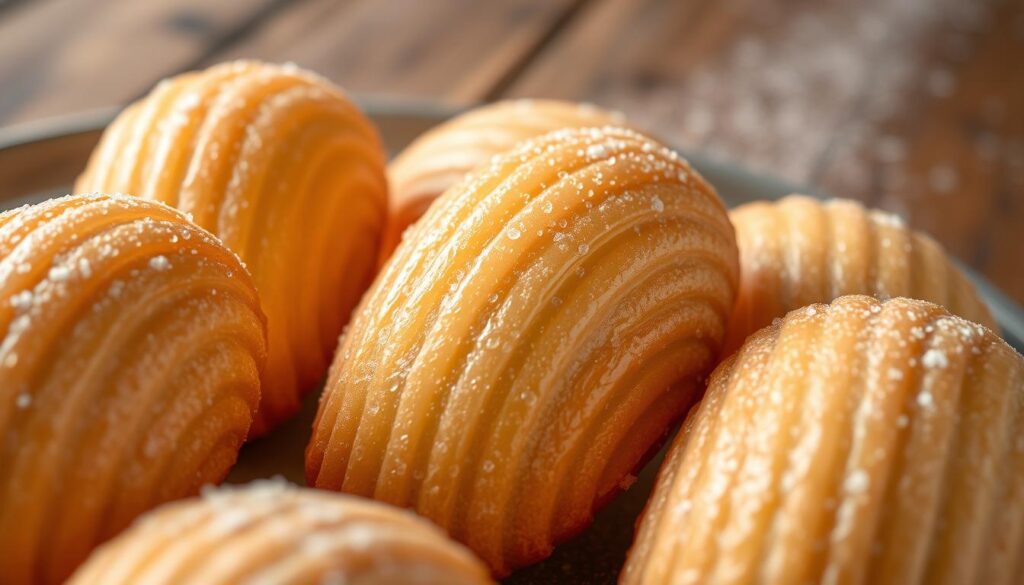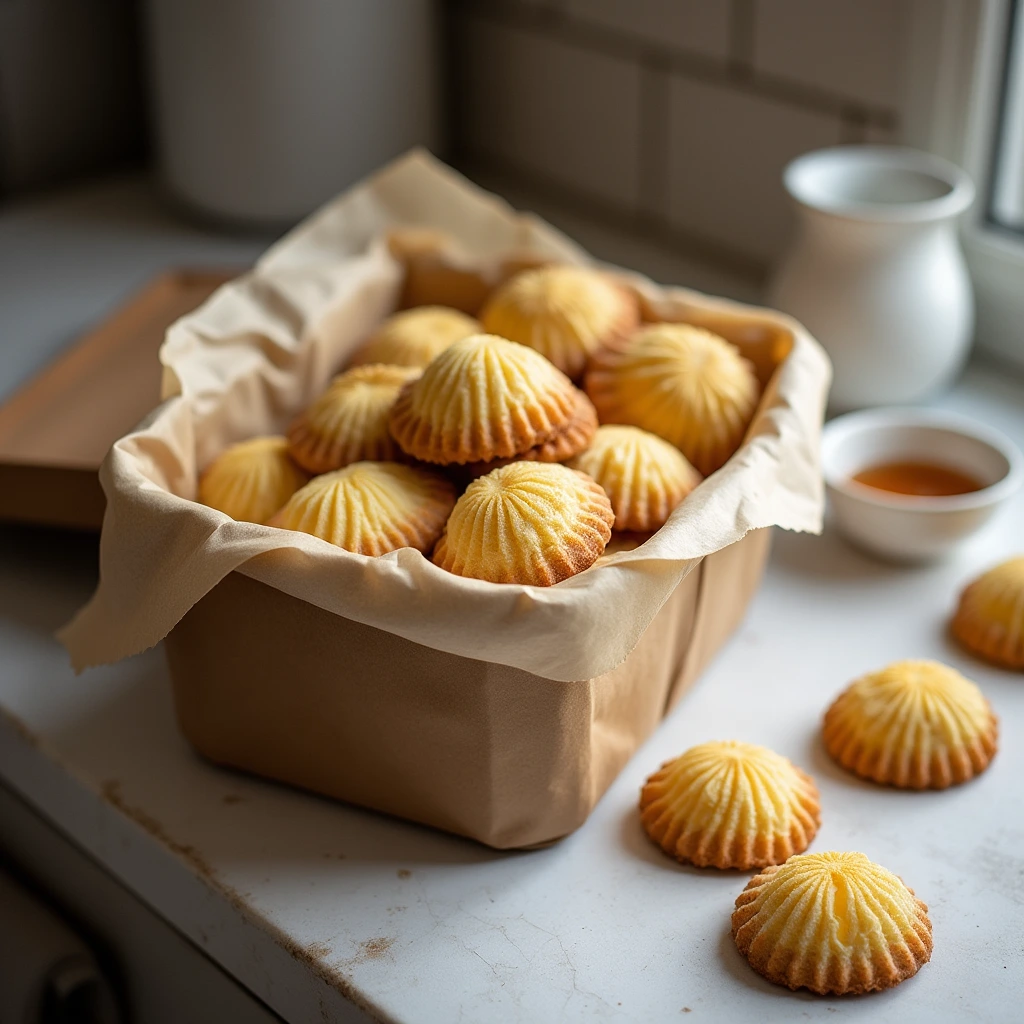Madeleines are famous French butter cakes known for their light texture and unique shape. They can be enjoyed on their own or with flavors like citrus and chocolate. This article will share expert tips to keep madeleines moist, so you get the perfect texture every time.
By using the right techniques and a classic recipe, you can avoid dry madeleines. You’ll learn how to make them rich and moist. With these baking tips, you’ll become a pro at making these delicious cookies.

Key Takeaways
- Madeleines are enhanced by incorporating moisture-rich ingredients like butter and oil.
- Chilling the batter can improve texture and lead to the iconic madeleine hump.
- Using honey in recipes helps retain moisture for longer periods.
- Correct baking times and temperatures are essential for achieving the perfect madeleine.
- Storage methods significantly affect the freshness and quality of madeleines.
- Experimenting with ingredients can lead to unique and flavorful variations.
Understanding Madeleines
Madeleines are a beloved part of French pastry history. They originated in the 18th century in France’s Lorraine region. These small cakes are known for their unique shape and soft, moist inside with a crispy outside.
Origin and Characteristics
The story of madeleines is filled with legends, but they are truly sponge cakes. They are famous for their shell shape, which adds to their charm. Their tender crumb and buttery taste make them perfect for tea or dessert.
Traditional Ingredients Used in Madeleines
To make these delicious pastries, certain ingredients are key. The main ones are:
- Eggs
- Sugar
- Flour
- Butter
- Baking powder
- Flavorings like vanilla and lemon zest
The recipe calls for three large eggs for a rich texture. But, some recipes use two or 2.5 eggs. Butter, making up about 50% of the recipe, keeps them moist. Adding lemon zest enhances the taste, making each bite special.

Importance of Moisture in Madeleines
The right amount of moisture is key to making perfect madeleines. It affects their texture and taste. A good madeleine has a crispy outside and a soft inside. This is thanks to the right moisture level.
When baked just right, madeleines feel great in your mouth. People love coming back for more.
Texture and Flavor
The right moisture makes madeleines soft and airy inside. The outside gets a golden-brown crust. This mix of textures and flavors is what makes them special.
Moisture helps create air bubbles. This is what gives madeleines their signature bump in the middle.
Role of Ingredients Contributing to Moistness
Many ingredients help keep madeleines moist. Eggs add a lot of water and help the batter hold together. Butter adds flavor and keeps them moist.
Different sweeteners, like sugar and honey, also play a part. Honey, in particular, helps keep madeleines fresh longer. Knowing how these ingredients work together is key to making moist madeleines.

| Ingredient | Moisture Contribution | Role in Texture |
|---|---|---|
| Eggs | 73% water content | Provides structure and leavening |
| Butter | Rich in fat | Ensures moistness and flavor |
| Sugars | Hygroscopic properties | Affects moisture retention and sweetness |
| Honey | High moisture content | Extends shelf life and adds moisture |
How to Keep Madeleines Moist?
To keep your madeleines soft and tender, focus on certain techniques and ingredients. Chilling the batter and using ingredients that keep moisture are key. These steps will help you get great results every time you bake.
Chilling the Batter for Optimal Results
Chilling the batter makes your madeleines better. It lets the flour soak up more liquid and relaxes the gluten. This makes the crumb tender, which is key for moist madeleines. Chilling for at least an hour is good, but overnight is even better.
Key Ingredients that Help Retain Moisture
The right ingredients are crucial for moist madeleines. A mix of butter, oil, and milk keeps them moist. Honey adds sweetness and softness. Here’s a list of important ingredients:
| Ingredient | Function |
|---|---|
| Butter | Provides richness and moisture |
| Oil | Enhances moisture retention |
| Milk | Offers additional moisture |
| Honey | Increases softness and adds sweetness |
| Sugar | Helps in moisture retention and flavor |
By focusing on these details, you can make madeleines that are moist and delicious.
Choosing the Right Madeleines Pan
Choosing the right pan is key to making perfect madeleines. A good pan helps you get that signature shell shape. Different pans have their own benefits, affecting both the baking and the look of your madeleines.
Benefits of a Non-Stick Pan
Non-stick pans make it easy to remove madeleines. They keep the cakes in shape and make them easy to take out. This is important for a nice presentation. Plus, they need less greasing and stick less, making baking better.
Using a Madeleines Pan vs. Alternative Options
A traditional madeleines pan is best for the classic shape. But, you can also use mini muffin tins or small tart pans. They might not give the exact shape or texture, but they can still work well.
| Pan Type | Number of Molds | Dimensions (inches) | Shape |
|---|---|---|---|
| Williams Sonoma Goldtouch Pro | 16 | 15.75 x 11 x 0.5 | Shell |
| Sur La Table Silicone Mold | 16 | 15.75 x 11.6 | Shell |
| Chicago Metallic | 12 | 15.8 x 7.8 x 0.9 | Shell |
| Chefmade Mini Pan | 16 | 12.9 x 10.2 x 0.6 | Shell |
| Combination Set | 3 (6 each) | 10.4 x 7.1 | Various Shapes |
In summary, the right madeleines pan is crucial for great results. A quality non-stick pan is a big help. But, other pans can also work well in your kitchen.
Expert Baking Techniques for Moist Madeleines
Getting moist madeleines right is all about the right baking techniques. Each step, from handling the batter to checking for doneness, matters. It’s all about achieving that perfect texture and taste.
Refrigerating the Batter and Pan
Chill both the batter and the madeleines pan before baking. This step is key for that special “hump” on top. Cold batter in a hot pan makes the madeleines rise beautifully, enhancing their texture.
Baking at the Right Temperature
The baking temperature is crucial for moist madeleines. Aim for 374°F to 400°F. This temperature range caramelizes the outside while keeping the inside fluffy and moist. Adjusting the temperature can greatly affect the result.
Checking for Proper Doneness
Using the right doneness tips is essential. Madeleines are done when they spring back and have a golden color. Overbaking can make them dry, ruining their texture and flavor.
| Technique | Description | Benefits |
|---|---|---|
| Refrigerating Batter | Chilling helps create a perfect rise | Achieves the signature hump |
| Baking Temperature | Maintaining 374°F to 400°F | Caramelizes outer layer and keeps insides moist |
| Checking Doneness | Spring back when touched | Ensures moistened texture without overbaking |
Common Mistakes to Avoid While Baking Madeleines
Baking madeleines needs precision and care. Many people make mistakes that can ruin their baking. Knowing how overbaking and wrong batter amounts can harm your madeleines is key to success.
Overbaking and Its Consequences
Timing is everything when baking madeleines. Overbaking can make them dry and lacking in flavor. The outside might look golden, but the inside will be hard and tasteless.
It’s important to watch the baking time closely. This way, you can get the perfect texture and flavor. The madeleines should have a soft center and a delicate hump.
Improper Batter Proportions
Getting the batter right is also crucial. Wrong amounts of ingredients can change the taste and feel of your madeleines. Too much flour makes them heavy, while not enough eggs can make them dry.
It’s important to measure everything correctly. This ensures your madeleines are light and full of flavor. The right mix of ingredients is what makes them so special.
| Common Baking Mistake | Effect on Madeleines |
|---|---|
| Overbaking | Results in dry texture and loss of moisture |
| Incorrect Flour to Egg Ratio | Creates density and affects moisture |
| Using Cold Ingredients | Affects texture and rise of madeleines |
| Skipping Chilling Steps | Prevents proper hydration and gluten relaxation |
Storing Madeleines to Maintain Freshness
Storing madeleines right is key to keeping their taste and texture. Using the right storage methods helps them stay moist and tasty. Here are tips for short-term and long-term storage.
Best Practices for Short-Term Storage
For short-term, store madeleines in an airtight container at room temperature. This keeps them fresh for 2 to 4 days. Enjoy them within this time for the best taste and texture.
If you wait too long, madeleines lose their moisture. This can make them less enjoyable to eat.
Long-Term Storage Solutions
For longer storage, wrap madeleines in plastic wrap and freeze them. This keeps their flavor and texture for up to three months. Freezing prevents freezer burn and keeps them moist.
When you’re ready, thaw them at room temperature for a couple of hours. Freezing them individually helps prevent sticking. This way, each madeleine stays in shape.
Variations of Madeleines That Can Stay Moist
Exploring variations of madeleines can make them taste better and stay moist. Two favorites are lemon madeleines and chocolate dipped madeleines. Each one adds a special touch to the classic treat, pleasing everyone’s taste buds.
Lemon Madeleines: Enhancing Flavor and Moisture
Lemon madeleines give the traditional recipe a fresh twist. They include lemon zest and juice, which brighten the taste. This citrus addition not only boosts flavor but also keeps the madeleines moist.
These madeleines are light and tangy, making them great for any time. They pair well with tea or coffee.
Chocolate Dipped Madeleines vs. Traditional
Chocolate dipped madeleines offer a richer taste with a simple touch. Dipping them in melted dark chocolate keeps them moist and adds a nice crunch. The chocolate outside contrasts with the soft inside, making them a treat for chocolate fans.
For the best taste, enjoy these madeleines right after baking. The chocolate should still be warm and gooey.
Conclusion
Mastering the art of baking madeleines is all about moisture. By following expert tips, anyone can make these French treats a hit. It’s all about choosing the right ingredients, chilling the batter, and avoiding common mistakes.
Every batch of madeleines is a chance to try something new. You can stick to traditional recipes or try exciting variations. Serving madeleines with tea or dessert wines makes the experience even better, creating special moments for everyone.
Getting the moisture right is key to making madeleines soft and spongy. With careful preparation and attention to detail, your kitchen will fill with heavenly aromas. Baking madeleines is a way to show off a classic dessert that everyone will love.
FAQ
How can I ensure my madeleines stay moist?
To keep your madeleines moist, use the right ingredients. This includes butter, eggs, and sugar. Always chill the batter before baking for the best results.
What is the ideal baking temperature for madeleines?
Madeleines bake best at temperatures between 374°F and 400°F. This temperature helps them rise and caramelize properly.
Can I use alternative pans to make madeleines?
Yes, you can use mini muffin tins or small tart pans instead of a traditional madeleines pan. But, they won’t give you the classic shape.
How long should I refrigerate the batter?
Chill the batter for at least 1 hour. But, chilling it overnight can make the madeleines even better in texture and moisture.
What are common mistakes that lead to dry madeleines?
Common mistakes include overbaking and not using enough moisture-retaining ingredients. Also, improper batter proportions can cause dryness.
How should I store madeleines to keep them fresh?
For short-term storage, keep madeleines in an airtight container at room temperature. For longer storage, wrap them tightly in plastic wrap and freeze for up to two months.
How can I add flavor while keeping madeleines moist?
Adding lemon zest or chocolate can enhance flavor. It also helps keep the madeleines moist.
Why is it important to chill the pan as well?
Chilling both the batter and the pan creates a temperature difference. This difference helps make the signature “hump” on top of the madeleines as they bake.

